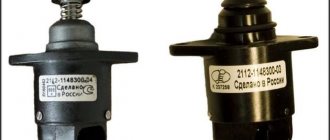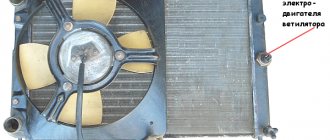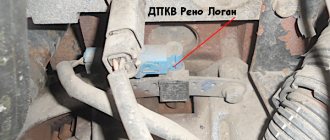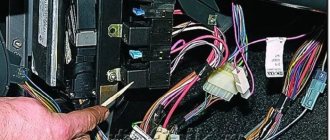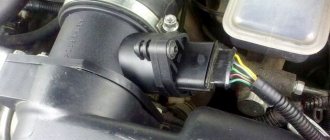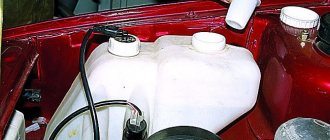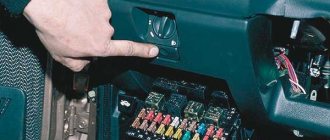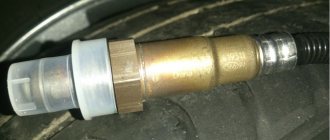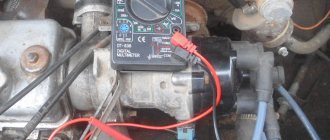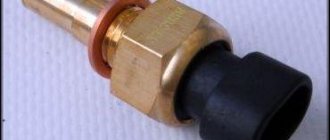01/26/2022 8 218 VAZ 2115
Author: Ivan Baranov
Russian-made cars today are equipped with a variety of electronic devices that make it possible to ensure the normal operation of many components and assemblies. In this article we will talk about the controllers and regulators that are installed on the VAZ. Where are the sensors located on the VAZ 2115, what is their purpose, what malfunctions can occur in the operation of the devices - read below.
[Hide]
Sensor panel VAZ 2115
The VAZ 2115 sensor panel includes the following devices:
- Speedometer. Shows the driver the current speed of the vehicle. The speedometer receives information about the vehicle's speed thanks to a sensor located on the gearbox.
- Tachometer. Located to the left of the speedometer. It is an electronic device that receives signals from the BC and reflects the current crankshaft speed.
- Fuel level indicator. Located to the right of the speedometer. Shows the amount of fuel in the tank.
- Coolant level indicator. Reports the coolant temperature. The pointer is located to the left of the tachometer. The information comes from the corresponding sensor.
Hall sensor replacement
Replacing the Hall sensor will not be particularly difficult. Even a novice car enthusiast can handle this work with his own hands.
The video below shows in some detail the process of replacing the sensor in the distributor of a UAZ car.
Typically, replacing a Hall sensor consists of several steps:
- First of all, the distributor is removed from the car.
- Next, remove the distributor cover and align the timing mechanism mark with the crankshaft mark.
- Having remembered the position of the distributor, you need to unscrew the fasteners with a wrench.
- If there are latches and stoppers, they should also be removed.
- The shaft is pulled out of the distributor.
- All that remains is to disconnect the terminals of the Hall sensor and unscrew it.
- By pulling back the regulator, the faulty part is carefully removed through the gap formed.
- The new Hall sensor is installed in the reverse order.
Checking the functionality of the Hall sensor not only allows you to accurately determine the cause of engine failure. Thanks to simple techniques, the motorist will save his time on repairs and also eliminate unnecessary waste of money.
VAZ 2115 sensor diagram
The sensors on the VAZ 2115 are located as follows:
- Phase sensor.
- Coolant temperature sensor.
- Knock sensor.
- Oil pressure sensor.
- Oxygen sensor.
- Crankshaft position sensor.
- Speed sensor.
- Idle speed sensor.
- DMRV.
- Fuel level sensor.
- Gasoline level sensor.
- Antifreeze level sensor.
- Throttle position sensor.
How to check the Hall sensor
A simple way to check the camshaft position (Hall) sensor is shown in the following video.
There are several ways to check the health of the Hall sensor. Each motorist can choose the most suitable option for himself:
- Take a working sensor from a neighbor or at a car disassembly for testing and install it instead of the “native” one. If the engine problems disappear, then you will have to buy a new part.
- Using a tester, you can measure the voltage at the sensor output. In a working device, the voltage will vary from 0.4 V to 11 V.
- You can create a simulation of a Hall sensor. To do this, remove the three-pin block from the distributor. Then turn on the ignition and connect outputs 3 and 6 of the switch with a piece of wire. The appearance of a spark indicates that the sensor has failed.
If the test reveals that the Hall sensor is faulty, then it must be replaced with a new one.
Temperature sensor VAZ 2115
DTOZH is distinguished by its simplicity of design and durability. Its only task is to monitor changes in coolant temperature. The electronic unit uses the information received from the sensor to regulate the crankshaft speed and the air-fuel mixture ratio, as well as to select the ignition timing.
How to warm up the engine correctly?
- In winter, we start the engine with the clutch depressed.
- The main mistake is that many people immediately turn on the heater, which is not necessary (by turning on the fan, you cool the engine).
- After 2 minutes of warming up (in summer), and after 5-6 minutes (in winter), slowly begin to move.
- Do not turn the engine above 2500 rpm until the temperature gauge reaches 90 degrees.
If you notice that your car takes a very long time to warm up, then pay attention to the following article: Why does the engine take a long time to warm up? It is also worth noting that by warming up the engine for too long, you waste excess fuel (about 1.5 liters per hour) and pollute the environment. And according to traffic rules, warming up the engine in residential areas is prohibited
Idle speed sensor VAZ 2115
The idle speed sensor is not only a device for reading indicators, but also a control device that directly affects the operation of the engine at idle speed.
This unit has an electric drive, as well as a conical needle that fits inside the throttle pipe. At idle speed, the DXX changes the position of the needle, closing or opening the pipe, thereby regulating the amount of air supplied to the throttle assembly.
Air flow meter (MAF)
One of the most expensive scanners, its breakdown is extremely unpleasant. It is installed in the air path immediately behind the filter and estimates the amount of air entering the manifold. Based on its readings, the ECU doses fuel; at idle it flows about 9 liters per hour, at 3 thousand revolutions - about 30 liters per hour.
Malfunctions and symptoms
This is one of the few sensors that cannot suddenly cause obvious signs of malfunction, but over time one can observe high fuel consumption, a drop in traction at the bottom, failures at high speeds, and problems with cold starts may arise. The CE lamp may come on.
How to check
If you suspect that the mass air flow sensor is operating correctly, you should remove the terminal connector and start the engine. If the idle speed increases above 1300 rpm, it is possible that the sensor requires replacement. This method is not precise, so it is better to use a multimeter and take simple measurements. The device is set to a measurement threshold of 2 V, the positive probe is connected to the far right wire (most often yellow), the negative probe is connected to the green wire, one contact from the positive one. The ignition is turned on, the engine is not started. The multimeter will show a minimum of 0.9 V, a maximum of 1.04 V. The last value is already critical and if the measurements show a higher voltage, the sensor is changed. An external inspection will also be useful: if there is an oil deposit on the surface, clean the sensor and repeat the test.
Speed sensor VAZ 2115
The speed sensor transmits information about the current vehicle speed using pulse signals. Depending on the frequency of receipt of these signals, the electronic unit determines the speed of the vehicle.
The information obtained is used to adjust the engine speed at idle. If the speed sensor breaks down, fuel consumption at idle increases significantly, the speedometer does not work and engine thrust decreases.
Speed sensor connector
Sensors, their purposes and malfunctions
Let's now talk in more detail about each of the sensors, let's look at where they are and what they look like.
Idle speed (IAC)
The device is located in the throttle assembly. It is a small induction coil with a needle inside. Depending on the controller readings, one or another voltage is applied to the coil winding and the needle extends a certain distance into the throttle pipe, regulating the air supply. With this, the idle speed is adjusted.
There is no indicator responsible for this sensor. Therefore, if this node fails, then this can be understood by the following “symptoms”:
- The engine stalls at idle or when changing speed;
- “Floating”, unstable idle speed;
- When turning on a cold engine, there is no increased speed.
To replace the sensor, you must turn off the power to the machine's wiring, completely disconnect the throttle assembly, and then remove the sensor from it, after first disconnecting the terminals that supply electricity to it. In place of the old sensor, you need to install a new device and place the throttle assembly in place.
Detonation (DD)
The knock sensor is located between the cylinders on a car engine and reacts when the fuel detonates inside the cylinder. In essence, it is a piezoelectric element. When gasoline detonates, the sensor converts the resulting vibrations into electricity. Current is supplied to the on-board computer and signals a fuel explosion. After this, the ignition timing is automatically adjusted.
If this type of sensor breaks down, the fuel begins to detonate in the engine. To check the device for functionality, you need to disconnect it using a key from its mounting location, connect it to a voltmeter and knock on it. If voltage was applied to the voltmeter, then the unit is working; if not, it is faulty.
To replace a device, you need to unscrew it from the seat using a key, disconnect the terminals from it and install a new device.
Oxygen (Lambda probe)
The oxygen sensor, also known as a lambda probe, is installed on the exhaust pipe close to the cylinders. It measures the amount of oxygen contained in exhaust gases and the environment. It only works when the engine is on, as it must be heated to function. When oxygen molecules hit the sensor, electricity is generated, which is supplied to the control unit. The on-board computer, based on sensor readings, regulates the supply of oxygen to the engine cylinders.
Crankshaft sensor VAZ 2115
DKPV is a device that supplies the electronic unit with information about the position of the crankshaft. The correct functioning of the injection engine injectors, the ignition system and the fuel mixture supply system depends on the operation of this unit.
This device is often called a synchronization sensor, since based on the data received from the DCPV, the electronic unit determines the moment of fuel injection into the cylinders of the power unit. If this sensor breaks down, incorrect information will be supplied to the “brains” of the car and the power unit will lose its functionality, since malfunctions will occur in the fuel supply system, and the injectors will not be able to function correctly. The DCPV is located near the camshaft, not far from the alternator belt.
DPKV
This sensor tells the ECU the current position of the crankshaft. It is inductive, that is, when the above node rotates, it produces certain impulses, the frequency of which allows the computer to make the necessary calculation. If the signal is lost, the power unit stops. That is, its malfunction will not even allow you to get to a car service center. Otherwise, it breaks very rarely.
In this situation, the ECU will show an error code - 0335. However, this does not always mean that it is the DPKV that has become unusable. Sometimes the same combination appears if the mass air flow sensor is not working properly.
Air sensor VAZ 2115
Thanks to the information received from the mass air flow sensor, the electronic unit regulates the optimal ratio of gas and gasoline in the fuel mixture, which is supplied to the engine injectors. If the device does not work correctly, the combustible mixture will not meet the requirements of the current operating mode of the engine, which entails a decrease in power and deterioration in dynamics, as well as increased fuel consumption.
Mass air flow
This sensor, like most others, transmits data to the motor control unit. Thanks to this information, the on-board computer adjusts the most optimal ratio of fuel and air volumes to form a combustible mixture. Subsequently, this mixture is supplied to the engine injectors. If this element does not work correctly or with errors, then the combustible mixture will ultimately not be able to meet the parameters of the operating mode of the power unit. Accordingly, this can ultimately lead to a decrease in engine thrust, as well as a deterioration in the dynamics of the vehicle as a whole.
In addition, failure of the mass air flow sensor can increase fuel consumption. As for the installation location, the device is located on the air filter element line, not far from the large inlet line. If malfunctions are detected, the controller does not need to be replaced - you can try to clean it yourself.
Loading …
Knock sensor VAZ 2115
A properly functioning knock sensor is the key to the normal functioning of a VAZ engine. If it breaks down, the engine will stall and fuel consumption will increase. The knock sensor responds to vibrations of the power unit, information about which is transmitted to the electronic unit, which allows the ECU to select the correct ignition timing. The device is mounted on the cylinder block near the fan.
Signs of DF malfunction
If you notice the following signs, then the DF has failed: When starting the engine, you noticed that the starter spins for 4 seconds and the check engine light is on. In this case, the ECU waits for readings from the DF, does not wait and relies on the system (according to the DPKV) Failures in the self-diagnosis mode Increased gasoline consumption Reduced engine dynamics DF error If the DF malfunctions, a check light comes on, which means error P0340 - “DF error” or “camshaft position sensor” faulty." But as mentioned earlier, the description of the problem is different, but the essence is the same: the DF and the camshaft position sensor are the same unit.
Source
Fan sensor VAZ 2115
This sensor is located in the heater radiator. There is a special contact group inside it. When the coolant in the radiator heats up, this group also heats up and expands. And when this expansion reaches the required limit, the contacts close, the signal is transmitted to the wiring and the fan turns on.
List of devices
Sensors are needed to report on the performance of systems, signal the level of cooling liquids and oil, and prevent or anticipate emergency situations.
These small devices, despite their size, play an incredible role in the performance of the machine. Therefore, it will not be superfluous to know which sensors are on your car.
Let us list the main ones present in the VAZ 2114 systems. We include sensors in this list:
Coolant temperature;
Coolant level in the expansion tank;
Mass air flow rate indicator;
Engine idling;
Brake fluid level in the system;
Camshaft position (it is called a phase sensor);
Outside air temperature;
Uneven road surface.
This list is very, very extensive. But even this, the owners of the VAZ 2114 do not want to stop, which is why they are introducing several more different sensors into the system:
- Light devices;
- Reverse;
- A device that signals open doors;
- Brake pad wear indicator, etc.
Phase sensor VAZ 2115
Phase sensor plug
The phase sensor transmits information to the electronic unit about the current operating cycle of the engine: which valve is open and which valve timing is currently being implemented. Based on the data received, the electronic unit determines the timing of fuel injection so that fuel is supplied just before the opening of the intake valve. The device is located on the engine, near the cylinder head, not far from the air filter.
Where are they located?
But knowing about their presence in your VAZ 2114 car is not enough. In case of problems, when the electronic control unit receives incorrect data from signaling devices, they have to be changed.
Whatever one may say, every sensor that has ceased to function properly and transmit correct data on the state of the systems to the electronic control unit must be replaced. Almost all sensors cost no more than a few hundred rubles. But even low cost and small size do not indicate the uselessness of these devices. Change devices promptly.
To do this, you need to understand how to get to this or that sensor. Therefore, we invite you to familiarize yourself with the location of key alarm and measurement devices.
On 8 valve engines it is located at the bottom of the valve cover in the cylinder head, and on 16 valve engines it is located on the left end of the camshaft bearing housing
Coolant temperature (engine temperature sensor)
Look for it near the tasty cylinder head cooling jacket pipe
Coolant level
It is located directly on the tank, inside of which there is coolant (antifreeze or antifreeze). Looks like a simple plastic cover that connects to an electrical connector
Brake fluid level
This is a float device located inside the brake fluid reservoir.
Idle speed (IAC)
Look near the throttle valve on the throttle body
Mass air flow
You will find it near the large intake pipe, directly on the air filter housing
Throttle Positions
Located on the throttle body
Crankshaft position (timing sensor)
Its location is near the electric generator drive pulley
Camshaft position (phase sensor)
Near the cylinder head cover, viewed from the air filter side
Oxygen (lambda probe)
Installed in front of the resonator in the intake manifold of the exhaust system
Located between cylinders 2 and 3 near the fan
It should be looked for inside the intake chamber of the fuel tank
Located directly on the gearbox
Look near the cup on the side of the right mudguard. You can get there through the engine compartment
Ambient temperatures
It is installed directly behind the front bumper, exactly in the middle
Each sensor has its own strictly designated place. Having studied their locations, you can easily replace devices in the event of breakdowns or malfunctions.
Some measuring and signaling devices are located literally on the surface, so there is no need to carry out additional dismantling work. To get to others, you will have to seriously dig into your VAZ 2114 and remove quite a few parts.
The integrity of your car, the safety of the driver, passengers and all other road users depend on their performance. Therefore, treat the sensors with appropriate respect, monitor their condition and change them in a timely manner if the need arises.
Several malfunctions that are often found on cars of the 2115 family.
Cooling system
If a malfunction occurs in the cooling system, pull off the road and stop the engine.
Open the hood and carefully inspect the engine compartment. If steam escapes, we determine a specific location. We inspect the engine, check the expansion tank for the position of the coolant level. In one step, we determine the condition of the thermostat, radiator, and rubber hoses in the engine cooling system.
Do not unscrew the expansion tank cap immediately after stopping the engine. In the cooling system, the liquid is under high pressure. When we unscrew the plug, the pressure drops sharply, and according to the laws of physics, the coolant boils. Naturally, its splashes can lead to burns to your hands and face. If there is an urgent need to unscrew the expansion tank cap on an engine that has not yet cooled down, you need to throw some thick fabric on top and only then slowly unscrew the cap.
Let’s not be too lazy to look under the instrument panel of the VAZ-2115. Underneath it, you may find leaks of coolant oozing from the heater or radiator tap.
If coolant leaks are caused by a burst hose, it can be temporarily patched with adhesive tape (duct tape, tape).
There are much more problems if the leak comes from the heater, radiator or thermostat. It is difficult to eliminate it along the way. In this situation, it is recommended to add water to the cooling system and monitor the temperature readings while driving. If necessary, the level in the cooling system will have to be restored periodically. Please note that if you use water instead of antifreeze for a long time, this will most likely provoke the formation of scale in the cooling system of the VAZ-2115. As a result, cooling will deteriorate and engine life will decrease. Therefore, after an emergency trip, be sure to fix the leak, drain the liquid diluted with water, flush the system and fill with fresh coolant. The most important condition is that it is prohibited to add cold water to an overheated engine! The engine must cool for at least half an hour with the hood open.
If the VAZ 2115 cooling system is faulty and no coolant leak is observed, check the integrity of fuse No. 5 (20A). It performs the function of forced protection of the on-board power circuit in the electric fan of the cooling system. The fuse is located in the mounting block located in the engine compartment. If the electric motor starts working after replacing the fuse, the journey can continue.
If the electric motor does not work after replacing the fuse, we will conduct additional diagnostics. Let's take two additional wires and supply power to the electric motor directly from the battery.
Please note that the wires must be insulated and securely fastened. Short circuits between wires must not be allowed! Be sure to pay attention to the polarity of the connection: the electric motor must rotate in such a way that the fan forces air onto the engine through the radiator, and the directions of the oncoming (path) air flow and the air flow generated by the fan coincide.
If the electric motor starts working after these manipulations, it means that the electrical wiring of the cooling system or the fan relay is faulty. The relay is located under the trim on the right side of the dashboard console of the VAZ 2115. If the engine is silent, there may be a malfunction of the electric motor itself or the wiring. Unfortunately, neither the electric motor nor the relay can be repaired and will require replacement.
The engine can also overheat if the thermostat fails. This unit regulates the flow of fluid through the cooling system either bypassing the radiator (to speed up the warm-up of a cold engine) or through the radiator. Checking the thermostat is not difficult: on a warm engine, we feel the lower hose connecting the radiator and the engine. If the hose is cold, the thermostat is most likely faulty, so coolant is not circulating through the radiator.
Throttle sensor VAZ 2115
TPS is one of the key devices, the correct operation of which affects the functioning of the fuel system. This sensor transmits information to the car’s “brains” at what angle the throttle valve is currently located.
One of the main characteristics of TPS is the signal frequency. Based on changes in signal frequency, the engine control unit determines the degree of pressure on the gas pedal, which allows the “brains” to select the most optimal engine cooling mode and the amount of fuel supplied.
How to determine if the engine is overheated
At first glance it seems very simple - according to the indicators of the engine temperature device, or - sensor. This is true, if not for one thing - novice motorists are so captivated by the road situation around them that they look at the instrument panel only in one case - how much fuel is left. Experienced motorists, on the contrary, due to their confidence in their abilities, also do not look at the car’s dashboard. And as a result, a situation often arises that overheating is detected when the engine temperature has long exceeded permissible limits, and irreparable damage has been caused to the engine. It is irreparable overheating that is one of the most complex malfunctions, which leads to very serious consequences. But more on that later.
But there is a way that will not let you miss the moment of overheating. This is problematic in a traffic jam, and is not always clearly present, but here’s what you should be aware of:
As soon as the engine temperature exceeds the permissible norm, when you sharply press the gas pedal, or when accelerating the car, even slightly, detonation knocks are clearly heard, which are popularly called “tapping fingers.” This is not true, but everyone knows this definition. If you hear such a sound, there is a 99% chance that the engine has overheated, and action must be taken.
Detonation knock is a loud metallic knock, the frequency of which coincides with the engine speed. You've probably heard such sounds when refueling with low-quality fuel. I personally don’t know where the concept of “tapping fingers” came from. But the real reason for such knocking noises is a disruption in the fuel combustion process. What you hear is nothing more than explosions of the fuel mixture. During normal engine operation, the combustion process is controlled, but as soon as one of the operating parameters is violated, the process goes out of control and combustion turns into an explosion. Hence the concept - detonation (from the word detonate - explode) knocks. When the engine overheats, this is the first sign.
What is the permissible engine temperature
Before continuing the conversation, let's define what is normal temperature and what is overheating. There is no one-word answer, but there are general rules. The engine temperature is within 85-95 degrees Celsius, which is working. Engine temperature up to 100 degrees is acceptable. This means that a short-term increase in temperature to 100, sometimes up to 105 degrees is allowed. Just for a short time - up to 5 minutes. Engine temperature above 105 degrees Celsius means overheating and action must be taken.
Consumption and travel distance
If we take into account the volume of the VAZ 2114 tank and the data on gasoline consumption (given in the table above), we can draw the following conclusions about the possible travel range.
When driving at a constant speed of 90 km/h, the maximum range can be almost 700 km without additional refueling.
When traveling in the so-called “mixed” city/highway mode, consumption will increase, which means the range will decrease (up to 640 km).
And when traveling only in city mode (taking into account standing in traffic jams and a large proportion of driving in low gears), fuel consumption will be maximum - almost 10 l/100 km. It is also worth considering that these figures are for new cars. For used cars they will be slightly higher.


